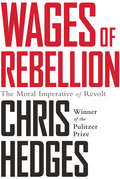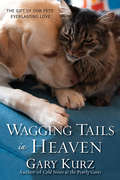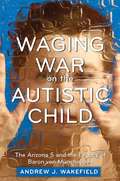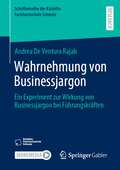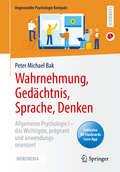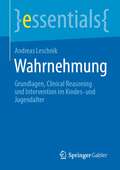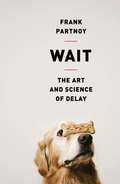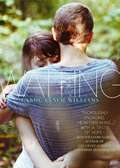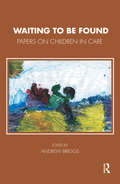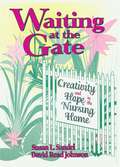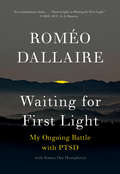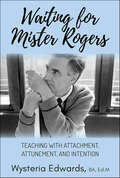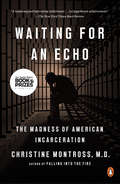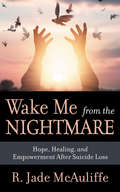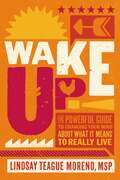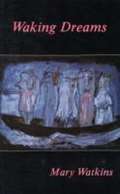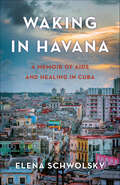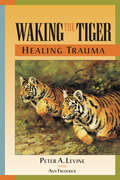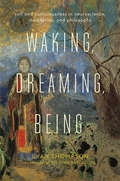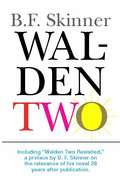- Table View
- List View
Wages of Rebellion
by Chris HedgesIn the face of modern conditions, revolution is inevitable. The rampant inequality that exists between the political and corporate elites and the struggling masses; the destruction wreaked upon our environment by faceless, careless corporations; the steady stripping away of our civil liberties and the creation of a monstrous surveillance system--all of these have combined to spark a profound revolutionary moment. Corporate capitalists, dismissive of the popular will, do not see the fires they are igniting. In Wages of Rebellion, Chris Hedges--a renowned chronicler of the malaise and sickness of a society in terminal moral decline--investigates what social and psychological factors cause revolution and resistance. Focusing on the stories of radicals and dissenters from around the world and throughout history, and drawing on an ambitious overview of prominent philosophers, historians, and novelists, Hedges explores what it takes to be a rebel in modern times. Hedges, using a term coined by the theologian Reinhold Niebuhr, cites "sublime madness” as the essential force that guides the actions of rebels--the state of passion that causes the rebel to engage in an unwavering fight against overwhelmingly powerful and oppressive forces. From South African activists who dedicated their lives to ending apartheid, to contemporary anti-fracking protestors in Canada, to whistleblowers in pursuit of transparency, Wages of Rebellion shows the cost of a life committed to speaking truth to power and demanding justice. This is a fight that requires us to find in acts of rebellion the sparks of life, an intrinsic meaning that lies beyond the possibility of success. For Hedges, resistance is not finally defined by what we achieve, but by what we become.
Wagging Tails in Heaven: The Gift Of Our Pets' Everlasting Love
by Gary KurzThe acclaimed author of Cold Noses at the Pearly Gates reveals the truth about cats, dogs, and their heavenly afterlives. Will our departed pets greet us on the other side? Are their spirits watching and protecting us right now? Will they be happy? If you've ever loved and lost a pet, you understand the power of a truly special bond. Animal or human, we are all God's creatures—and the love we share must surely be eternal. In this enlightening book, author Gary Kurz offers surprising and comforting evidence of an animal afterlife. Wagging Tails in Heaven reveals what the Bible says about the souls of animals; how pet angels devote themselves to humanity; what your dog or cat might look like in heaven; and what to expect when you&’re reunited on a spiritual plane. It also shares amazing firsthand accounts of &“ghost pet&” visitations, animal communications from beyond, and heartwarming tales of heroism, loyalty, and everlasting love.
Waging War on the Autistic Child: The Arizona 5 and the Legacy of Baron von Munchausen
by Andrew J. WakefieldAs the number of children diagnosed with autism spectrum disorders grows each year, new discoveries and controversies arise. Andrew Wakefield explores many of these in his thorough investigation of the recent trial case of the "Arizona 5,” which destroyed an Arizona family. Two parents, with five children on the spectrum, were accused of Munchausen syndrome by proxy-a rare form of child abuse-and were ganged up on by physicians, child protective services, and the courts, who alleged that the parents fabricated medical symptoms in all five children. However, Wakefield now presents ample evidence that was disregarded and that would have proven the parents’ innocence.Families affected by autism suffer great hardship and prejudice, particularly as they navigate the uncertain waters of diagnosis, treatment, and education. The shocking story of the Arizona 5 family delves into the tremendous challenges some parents have to face, especially if their views on how to treat the syndrome don’t align with the medical world’s standards. Wakefield also includes numerous studies and research trials that support the controversial yet significant roles that vaccines and diet play in autism, factors many medical professionals wrongfully dismiss.
Wahrnehmung von Businessjargon: Ein Experiment zur Wirkung von Businessjargon bei Führungskräften (Schriftenreihe der Kalaidos Fachhochschule Schweiz)
by Andrea De Ventura RajabIn der Chefetage werden keine Leistungen mehr erbracht oder Herausforderungen angenommen. Nein, heutzutage wird „performed“ oder „Challenges“ werden „proaktiv“ angegangen. Die Managersprache ist gespickt mit Floskeln, Worthülsen und inhaltsleeren Phrasen. Wer so spricht, klingt irgendwie wichtig und professionell und wer dazu gehören will, muss den Jargon beherrschen. Doch wie wirkt diese, mit englischen und denglischen Ausdrücken gespickte Sprache auf die Mitarbeitenden? Um diese Frage zu beantworten, wurde im Rahmen dieser Bachelorarbeit eine empirische Studie durchgeführt. Die Probanden beurteilten einen fiktiven Geschäftsführer bezüglich der Variablen Kompetenz, Glaubwürdigkeit, Sympathie und Erfolg. Die Versuchsbedingungen wurden dabei möglichst realitätsgetreu gestaltet um auch die Frage zu beleuchten, inwiefern nonverbale Signale wie Aussehen, Mimik und Gestik die Eindrucksbildung beeinflussen.
Wahrnehmung, Gedächtnis, Sprache, Denken: Allgemeine Psychologie I – das Wichtigste, prägnant und anwendungsorientiert (Angewandte Psychologie Kompakt)
by Peter Michael BakDieses prägnante Lehrbuch enthält die wichtigsten psychologischen Theorien und Konzepte aus den Bereichen Wahrnehmung, Aufmerksamkeit, Gedächtnis, Sprache und Denken. Es ist speziell für Studierende konzipiert, die sich einen starken Praxisbezug wünschen. Die sorgfältige Didaktik, Klausurfragen, digitale Zusatzmaterialien und Zusammenfassungen stellen eine optimale Grundlage für das Verstehen des Lehrstoffes und die Prüfungsvorbereitung im Bereich der Allgemeinen Psychologie I dar. Durch zahlreiche Anwendungsbeispiele, eingebundene Audioclips und Online-Zusatzmaterialien ist es in einzigartiger Weise anwendungsorientiert und weckt dadurch Lust, das Gelernte gedanklich weiterzuentwickeln und in verschiedensten Kontexten umzusetzen. Zusätzlich sind Fragen und Antworten zum Selbsttest über die SN Flashcards Lern-App inkludiert. Der Zugangscode befindet sich im gedruckten Buch.
Wahrnehmung: Grundlagen, Clinical Reasoning und Intervention im Kindes- und Jugendalter (essentials)
by Andreas LeschnikIn diesem essential werden die Grundlagen der Wahrnehmung erklärt. Außerdem gibt es einen kurzen Überblick über die kindliche Entwicklung der Wahrnehmung. Zudem werden Faktoren aufgezählt, die die Wahrnehmung beeinflussen können. Im weiteren Verlauf wird das hypothetisch-deduktive Clinical Reasoning zum Erstellen einer therapeutischen Diagnose bei Kindern- und Jugendlichen mit Wahrnehmungsstörungen eingesetzt. Am Ende bietet dieses essential Interventionsmöglichkeiten für Kinder und Jugendliche, um einzelne Wahrnehmungsfelder zu verbessern.
Wait: The Art and Science of Delay
by Frank PartnoyWhat do these scenarios have in common: a professional tennis player returning a serve, a woman evaluating a first date across the table, a naval officer assessing a threat to his ship, and a comedian about to reveal a punch line? In this counterintuitive and insightful work, author Frank Partnoy weaves together findings from hundreds of scientific studies and interviews with wide-ranging experts to craft a picture of effective decision-making that runs counter to our brutally fast-paced world. Even as technology exerts new pressures to speed up our lives, it turns out that the choices we make--unconsciously and consciously, in time frames varying from milliseconds to years--benefit profoundly from delay. As this winning and provocative book reveals, taking control of time and slowing down our responses yields better results in almost every arena of life ... even when time seems to be of the essence. The procrastinator in all of us will delight in Partnoy's accounts of celebrity "delay specialists," from Warren Buffett to Chris Evert to Steve Kroft, underscoring the myriad ways in which delaying our reactions to everyday choices--large and small--can improve the quality of our lives.
Waiting
by Carol Lynch WilliamsAfter her brother's death, a teen struggles to rediscover love and find redemption in this gripping novel.Growing up, London and Zach were as close as could be. And then Zach dies, and the family is gutted. London's father is distant. Her mother won't speak. The days are filled with what-ifs and whispers: Was it London's fault? Alone and adrift, London finds herself torn between her brother's best friend and the handsome new boy in town as she struggles to find herself--and ultimately redemption--in this authentic and affecting novel from award-winning novelist Carol Lynch Williams.ncy of a pair of loving sisters who are savaged by a dysfunction or disturbed mother. That sick chemistry, the fact that the caretaker entrusted with the greatest responsible is the perpetrator of unspeakable trauma, makes this story chilling and unforgettable. Fortunately, Williams doesn't lead her readers to the brink of the chasm of despair and shove them in; instead, she demonstrates how courage, resilience, and love can help young people in the most dire of situations survive. This is a book I will read again and one I will recommend to teachers and to my own students." Chris Crowe, author, professor at BYU and former ALAN president.
Waiting
by Carol Lynch WilliamsAfter her brother's death, a teen struggles to rediscover love and find redemption in this "stunningly powerful free-verse story" (VOYA).Growing up, London and Zach were as close as could be. And then Zach dies, and the family is gutted. London's father is distant. Her mother won't speak. The days are filled with what-ifs and whispers: Was it London's fault? Alone and adrift, London finds herself torn between her brother's best friend and the handsome new boy in town as she struggles to find herself--and ultimately redemption--in this authentic and affecting novel from award-winning novelist Carol Lynch Williams.
Waiting To Be Found: Papers on Children in Care (Tavistock Clinic Series)
by Andrew BriggsThis book explores the importance of relationship between child and care system, child and clinician or other practitioner, practitioners with practitioners, or individuals with the organisation in which they work. It presents the analytic and multifaceted centrality of relationship concept.
Waiting at the Gate: Creativity and Hope in the Nursing Home
by David Johnson Susan L SandelHere is the result of over ten years of hands-on clinical experience by two experts wha have worked with the elderly. The authors explore the contributions of the creative arts therapies, specifically movement and drama therapy, to the individual and communal welfare of residents in nursing homes. Waiting at the Gate: Creativity and Hope in the Nursing Home eloquently demonstrates how movement and drama therapy facilitate the preservation of life, of meaning, and of hope by seeking the beautiful and playful aspects of the self, and valuing humor, flexibility, and spontaneity in relationships with others. The authors show how these values challenge the “waiting to die” phenomenon of the custodial nursing home and offer lively alternatives to the resident in the new institution of the 1990s.
Waiting for First Light: My Ongoing Battle with PTSD
by Romeo Dallaire<p>At the heart of <i>Waiting for First Light</i> is a no-holds-barred self-portrait of a top political and military figure whose nights are invaded by despair, but who at first light faces the day with the renewed desire to make a difference in the world. <p>Roméo Dallaire, traumatized by witnessing genocide on an imponderable scale in Rwanda, reflects in these pages on the nature of PTSD and the impact of that deep wound on his life since 1994, and on how he motivates himself and others to humanitarian work despite his constant struggle. Though he had been a leader in peace and in war at all levels up to deputy commander of the Canadian Army, his PTSD led to his medical dismissal from the Canadian Forces in April 2000, a blow that almost killed him. But he crawled out of the hole he fell into after he had to take off the uniform, and he has been inspiring people to give their all to multiple missions ever since, from ending genocide to eradicating the use of child soldiers to revolutionizing officer training so that our soldiers can better deal with the muddy reality of modern conflict zones and to revolutionizing our thinking about the changing nature of conflict itself. <p>His new book is as compelling and original an account of suffering and endurance as Joan Didion's <i>The Year of Magical Thinking</i> and William Styron's <i>Darkness Visible</i>.</p>
Waiting for Mister Rogers: Teaching with Attachment, Attunement, and Intention
by Wysteria EdwardsEvery day children enter classrooms crying out for love and relief. Waiting for Mister Rogers reveals a Kindergarten teacher's journey to find answers for the broken children entering her classroom—and the wounds in her own heart—through the personal notes, speeches, and writings of Fred Rogers. Many moments of adversity, violence, and suffering can be traced back to broken attachments in childhood. These early attachment wounds follow children into adulthood, often damaging their interpersonal relationships. Where the world offers shallow and complex solutions, the gentle work of Mister Rogers models simple and deep ways to heal insecure attachment. Waiting for Mister Rogers, answers questions of personal development and connection for anyone seeking support, such as:What do children need to be securely attached? How can teachers heal their wounds to be fully present, intentional, and effective with their students? Could student be triggering a teacher’s childhood trauma? Can teachers go deeper while doing less?It's time to remember childhood, return to the Neighborhood and teach with attachment, attunement, and intention. Mister Rogers was right all along!
Waiting for an Echo: The Madness of American Incarceration
by Christine Montross*New York Times Books to Watch for in July**Time Best New Books July 2020*Galvanized by her work in our nation's jails, psychiatrist Christine Montross illuminates the human cost of mass incarceration and mental illnessDr. Christine Montross has spent her career treating the most severely ill psychiatric patients. Several years ago, she set out to investigate why so many of her patients got caught up in the legal system when discharged from her care--and what happened to them therein.Waiting for an Echo is a riveting, rarely seen glimpse into American incarceration. It is also a damning account of policies that have criminalized mental illness, shifting large numbers of people who belong in therapeutic settings into punitive ones.The stark world of American prisons is shocking for all who enter it. But Dr. Montross's expertise--the mind in crisis--allowed her to reckon with the human stories behind the bars. A father attempting to weigh the impossible calculus of a plea bargain. A bright young woman whose life is derailed by addiction. Boys in a juvenile detention facility who, desperate for human connection, invent a way to communicate with one another from cell to cell. Overextended doctors and correctional officers who strive to provide care and security in environments riddled with danger. In these encounters, Montross finds that while our system of correction routinely makes people with mental illness worse, just as routinely it renders mentally stable people psychiatrically unwell. The system is quite literally maddening.Our methods of incarceration take away not only freedom but also selfhood and soundness of mind. In a nation where 95 percent of all inmates are released from prison and return to our communities, this is a practice that punishes us all.
Wake Me from the Nightmare: Hope, Healing, and Empowerment After Suicide Loss
by R. Jade McAuliffeWake Me from the Nightmare helps people awaken from the nightmare of suicide loss. Survivors of suicide loss are left to live in a chronic state of shock, horror, and devastation. Broken and raw, they forge on, while plagued with pain, disruptive thoughts, and unanswered questions. The terrain of traumatic grief is complicated at best and precarious at worst. R. Jade McAuliffe understands this balance. After losing her sister in 2015, what kept her alive was her refusal to stay quiet and her willingness to stay connected, and on the other side of her personal wreckage, she found brand-new life. McAuliffe shares her discoveries, including how acknowledging pain will help to heal it, why protecting energy is vital for maintaining health and sanity, why people don’t have to “get over” their loss in order to heal it, and so much more. Wake Me from the Nightmare guides readers to a safe place where they can move through their own emotional wreckage—and save their own life.
Wake Up!: The Powerful Guide to Changing Your Mind About What It Means to Really Live
by Lindsay Teague MorenoWhy would you settle for an ordinary life when you have an extraordinary mind? Break your good life into six bite-size pieces so you can live a successful life without regret. What this world needs now more than ever are women who think differently. Every action taken or decision made is affected by our thoughts, mindset, and beliefs about the world. Our fears, excuses, procrastination, and self-sabotage must change if we want to impact our lives in any meaningful way. So, what is the secret to discovering lasting fulfillment in a culture that wants us sleeping? In Wake Up!, Lindsay Teague Moreno explores the six core foundations for a fulfilled life and the mindset shift that can occur when you stop looking at the expectations you put on yourself. Through stories and tough questions, you will emerge more prepared to live the kind of life that feels right, regardless of what other people think of it. In the areas of relationships, health, finance, business, and personal and spiritual life, Wake Up! will help you assess what you believe and how that affects your success. Then Moreno walks you through how to burn down the old ways to build the life of your dreams by:Squeezing lessons out of life&’s biggest letdowns,Finding fulfillment in the middle of the fire,Shifting your mindset to control your thoughts and make the future happen on purpose, andLiving a life with no excuses and nothing to lose.&“Creating a vision of the life we&’d like to live isn&’t hard. In fact, it&’s pretty fun and satisfying,&” says Moreno. &“It&’s easy to see all the problems we have now and say, &‘If this wasn&’t a problem, then I&’d be happy.&’ But that&’s just a lie we tell ourselves to keep ourselves safe and warm in the house and story we&’ve built for ourselves.&”Moreno will also share ways you can change your mindset in each core foundation so that your life works for you, rather than the other way around. Perfect for women who work inside or outside the home, Wake Up! will show you why it&’s so important to understand how and why we change our minds and wake up to what we really believe.Only you can emit that special energy that comes from being brave enough to live a life you'll never regret. Whole-life fulfillment is only a mindset shift away.
Waking Dreams
by Mary WatkinsMary Watkins, an imaginal psychologist, recovers the immeasurable riches of fantasy life, waking dreams, active imagination, and imaginal others, showing with lucid clarity and remarkable care the relevance of fantasy to the practice of psychotherapy, education, and the drama of individual lives. At once historical, critical, and clinical, this book describes American and European approaches to the image, finally delivering readers to their own relation to the imaginal world.
Waking in Havana: A Memoir of AIDS and Healing in Cuba
by Elena SchwolskyIn 1972, when she was a young, divorced, single mother, restless and idealistic, Elena Schwolsky made a decision that changed her life: leaving her eighteen-month-old son with his father, she joined hundreds of other young Americans on a work brigade in Cuba. They spent their days building cinderblock houses for workers and their nights partying and debating politics. The Cuban revolution was young, and so were they. At a moment of transition in Schwolsky’s life, Cuba represented hope and the power to change. Twenty years later, she is drawn back to this forbidden island, yearning to move out of grief following the death of her husband from AIDS and feeling burned out after spending ten years as a nurse on the frontlines of the epidemic. Back in Cuba, she experiences the chaotic bustle of a Havana most Americans never see—a city frozen in time yet constantly changing. She takes readers along with her through her humorous attempts to communicate in a new language and navigate this very different culture—through the leafy tranquility of the controversial AIDS Sanitorium and into the lives of the resilient, opinionated, and passionate Cubans who become her family and help her to heal.
Waking the Tiger - Healing Trauma: The Innate Capacity to Transform Overwhelming Experiences
by Peter A. Levine Ann FrederickA breakthrough book on the healing of trauma by the developer of Somatic Experiencing
Waking the Tiger: The Innate Capacity to Transform Overwhelming Experiences
by Peter A. Levine Ph.D.Now in 24 languages.Nature's Lessons in Healing Trauma...Waking the Tiger offers a new and hopeful vision of trauma. It views the human animal as a unique being, endowed with an instinctual capacity. It asks and answers an intriguing question: why are animals in the wild, though threatened routinely, rarely traumatized? By understanding the dynamics that make wild animals virtually immune to traumatic symptoms, the mystery of human trauma is revealed.Waking the Tiger normalizes the symptoms of trauma and the steps needed to heal them. People are often traumatized by seemingly ordinary experiences. The reader is taken on a guided tour of the subtle, yet powerful impulses that govern our responses to overwhelming life events. To do this, it employs a series of exercises that help us focus on bodily sensations. Through heightened awareness of these sensations trauma can be healed.
Waking, Dreaming, Being: Self and Consciousness in Neuroscience, Meditation, and Philosophy
by Evan ThompsonCognitive science joins with Asian contemplative traditions and philosophy to bring revolutionary meaning to the human experience.
Waking, Dreaming, Being: Self and Consciousness in Neuroscience, Meditation, and Philosophy (To The Point)
by Evan ThompsonA renowned philosopher of the mind, also known for his groundbreaking work on Buddhism and cognitive science, Evan Thompson combines the latest neuroscience research on sleep, dreaming, and meditation with Indian and Western philosophy of mind, casting new light on the self and its relation to the brain. Thompson shows how the self is a changing process, not a static thing. When we are awake we identify with our body, but if we let our mind wander or daydream, we project a mentally imagined self into the remembered past or anticipated future. As we fall asleep, the impression of being a bounded self distinct from the world dissolves, but the self reappears in the dream state. If we have a lucid dream, we no longer identify only with the self within the dream. Our sense of self now includes our dreaming self, the "I" as dreamer. Finally, as we meditate—either in the waking state or in a lucid dream—we can observe whatever images or thoughts arise and how we tend to identify with them as "me." We can also experience sheer awareness itself, distinct from the changing contents that make up our image of the self. Contemplative traditions say that we can learn to let go of the self, so that when we die we can witness its dissolution with equanimity. Thompson weaves together neuroscience, philosophy, and personal narrative to depict these transformations, adding uncommon depth to life's profound questions. Contemplative experience comes to illuminate scientific findings, and scientific evidence enriches the vast knowledge acquired by contemplatives.
Walden
by Henry D. ThoreauOne of the most influential and compelling books in American literature, Walden is a vivid account of the years that Henry D. Thoreau spent alone in a secluded cabin at Walden Pond. This edition--introduced by noted American writer John Updike--celebrates the perennial importance of a classic work, originally published in 1854. Much of Walden's material is derived from Thoreau's journals and contains such engaging pieces from the lively "Where I Lived, and What I Lived For" and "Brute Neighbors" to the serene "Reading" and "The Pond in the Winter." Other famous sections involve Thoreau's visits with a Canadian woodcutter and with an Irish family, a trip to Concord, and a description of his bean field. This is the complete and authoritative text of Walden--as close to Thoreau's original intention as all available evidence allows. This is the authoritative text of Walden and the ideal presentation of Thoreau's great document of social criticism and dissent.
Walden
by Henry David Thoreau Stephen FenderIn 1845 Henry David Thoreau began a new life, spending most of each week for over two years in a rough hut he built himself on the northwest shore of Walden Pond, just a mile and a half from his home town of Concord, Massachusetts. Walden is Thoreau's autobiographical account of this experiment in solitary living, his refusal to play by the rules of hard work and the accumulation of wealth and, above all, the freedom it gave him to adapt his living to the natural world around him. This new edition traces the sources of Thoreau's reading and thinking and considers the author in the context of his birthplace and his sense of its history - social, economic, and natural. In addition, an ecological appendix provides modern identifications of the myriad plants and animals to which Thoreau gave increasingly close attention as he became acclimatized to his life at Walden. Long-revered by political reformers and environmentalists, Walden is here reassessed by Stephen Fender, whose edition is based on research into the material conditions of Thoreau's life in Concord, and the town's place in the history of mid-nineteenth-century New England. [This text is listed as an example that meets Common Core Standards in English language arts in grades 11-12 at http://www.corestandards.org.]
Walden Two (Hackett Classics)
by B. F. SkinnerA reprint of the 1976 Macmillan edition.This fictional outline of a modern utopia has been a center of controversy ever since its publication in 1948. Set in the United States, it pictures a society in which human problems are solved by a scientific technology of human conduct.
